Hard-to-Find LEGO Colors (and what to do about it)
Bringing back one retired LEGO color in 2018 raises an important question—how useful are the 39 colors that we already have? Let’s see how many colors are available in enough different parts that you can actually build what you want!
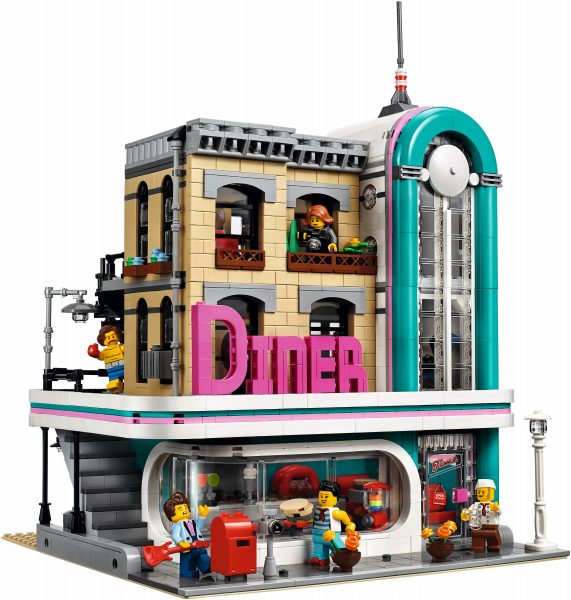
#10260 Downtown Diner is the first set since 2005 to include parts in color 107—Bright Bluish Green (Dark Turquoise/Teal).
This was the first new color since the Friends line was introduced in 2012; that’s when they added 326—Spring Yellowish Green, 323—Aqua, 322—Medium Azur, and 324—Medium Lavender. This was in addition to 323—Aqua, 321—Dark Azur, and 325—Lavender which were added in 2011. (2012 also brought us 330—Olive Green with Monster Fighters and Dino sets.)
LEGO fans make a big deal when a color is retired, added, or changed slightly—but does it really make a big difference for model builders? Certainly new colors can make a big difference, but it typically takes a long time for a new color to be available in a wide range of parts. As you will see, many new colors remain limited to a small selection of parts for a very long time, thus limiting their usefulness.
Related Links: The Rambling Brick: “Teal We Meet Again: In search of Stafford’s Choice”, New Elementary: “Contest: Kill Teal”, The Brick Blogger: “LEGO Downtown Diner & the return of teal”, Brickset: “Teal we meet again”.
Rather than just celebrate that we now have one more LEGO color to choose from, let’s take a deeper look at the existing solid colors to see how easy it is to use the 39 colors we already have.
All colors are not created (in) equal (quantities)
In this article, I have done a detailed analysis of which colors are most common in sets from the last 5 years. This has been done before, which is why I took the analysis one step further and looked at the 24 most common basic bricks/plates/tiles as a way of gaining insight into not only how many parts are made in each color, but which colors are offered in the widest selection of useful parts.
What we find is that the 10 most common colors account for almost 80% of the LEGO bricks which are produced every year. Since the remaining 30 colors make up just 20% of the parts being produced, the remaining colors range from relatively uncommon to very rare.
The top 10 colors are (in order):
- 194—Medium Stone Grey (Light Bluish Gray), 15%.
- 1—White, 13%.
- 199—Dark Stone Grey (Dark Bluish Gray), 11%.
- 26—Black, 11%.
- 5—Brick Yellow (Tan), 7%.
- 192—Reddish Brown, 6%.
- 21—Bright Red (Red), 5%.
- 24—Bright Yellow (Yellow), 4%.
- 138—Sand Yellow (Dark Tan), 4%.
- 23—Bright Blue (Blue), 3%.
Percentages based on buying one of every set released in 2013-2017, and sorting the 24 most common bricks/plates/tiles by color.
This article looks closely at these less common colors, and helps you understand how to make the most of each of these colors in your MOC’s. To keep the conversation manageable, we will only look at the 24 most common bricks, plates, and tiles, although the same patterns play out across the whole range of parts.
Common, Uncommon, and Rare Colors
It would be easy enough to sort all of the colors by the quantity of parts produced in each color, and somewhat arbitrarily draw lines between those colors which are common, uncommon, and rare. Instead, I added a second dimension to the groupings—In how many common parts does each color come?

Quantity of common Bricks, Plates and Tiles in each color, if you bought one of every set from 2013-2017.
Amazingly, none of these 24 common parts are currently available in all 40 solid colors. This means that LEGO artists who choose less common colors will need to work around situations where the part they need is not available in the color they want to use.
While it isn’t the focus of this article, some of the workarounds include: re-designing the model, using a similar color, buying horribly overpriced non-production parts, or even cutting parts to a smaller size.
That’s why it’s beneficial to break the color palette into categories:
- Common colors – Colors which are available in almost every common part, allowing you build whatever you want with very few part substitutions.
- Uncommon Colors – Colors which are available in a lot of parts, but are missing enough parts to make them frustrating to build with.
- Rare Colors – Colors which are available in so few parts that you can only really use them as an accent color in your models.
While the chart is hard to read, you can see black squares which represent parts which are not available in that color, and the red colors represent parts which are “rare” in that color because they come in very few sets. The colors were organized from left (common) to right (rare).
Common Colors

The following chart zooms-in on the first 17 colors in the previous chart. These are the most common colors—each of these colors is available in almost all of the 24 common parts included in this analysis. While some of these colors are significantly more common than others, they are all great choices for the main color while building your next great MOC. If you don’t have the parts you need, common parts in these colors are readily available online.
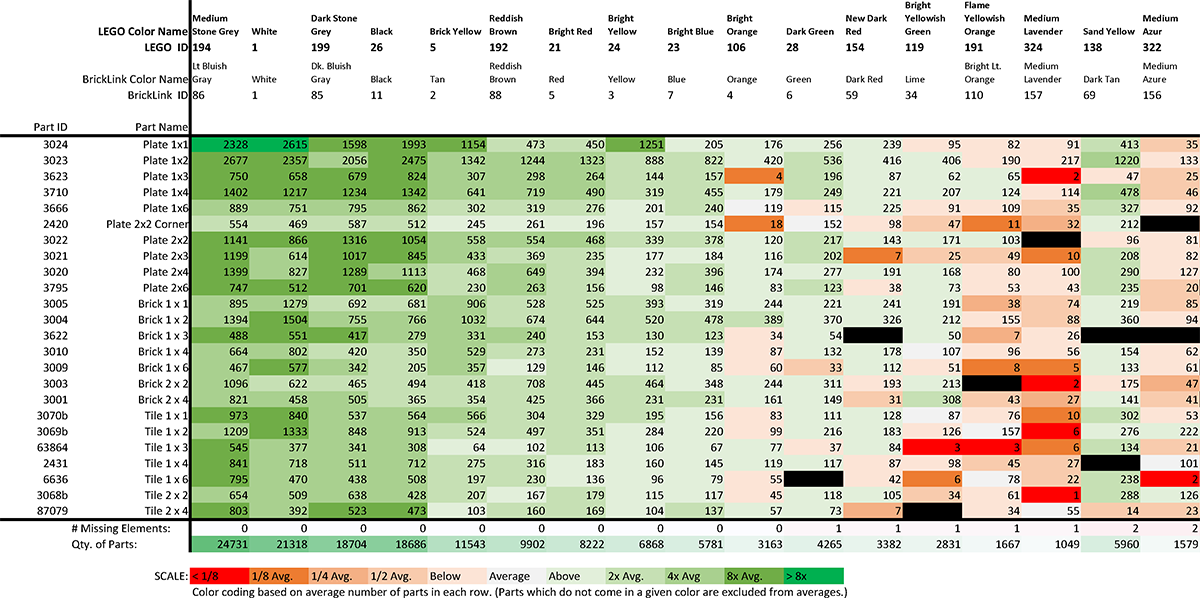
17 colors are available in all but two of these common parts.
In addition to the classic LEGO colors, a few relatively new colors are already available in most common parts:
- 154—Dark Red was introduced in 2001.
- 138—Sand Yellow (Dark Tan) was introduced in 2002, and is already in the top 10 most common colors for basic parts.
- 191—Flame Yellowish Orange (Bright Light Orange) was introduced in 2004. It has slowly become available in most basic parts while remaining relatively uncommon.
- 324—Medium Lavender and 322—Medium Azur make the list, which is noteworthy since they were only introduced in 2012, and most parts from these colors have only appeared in a few sets.
Uncommon Colors

Next, we see the colors that are frustrating because between 4 and 9 out of the most common 24 LEGO parts are missing. You also need to remember that many of the specialty parts which are popular for adding smaller details to LEGO models are not available in these colors.
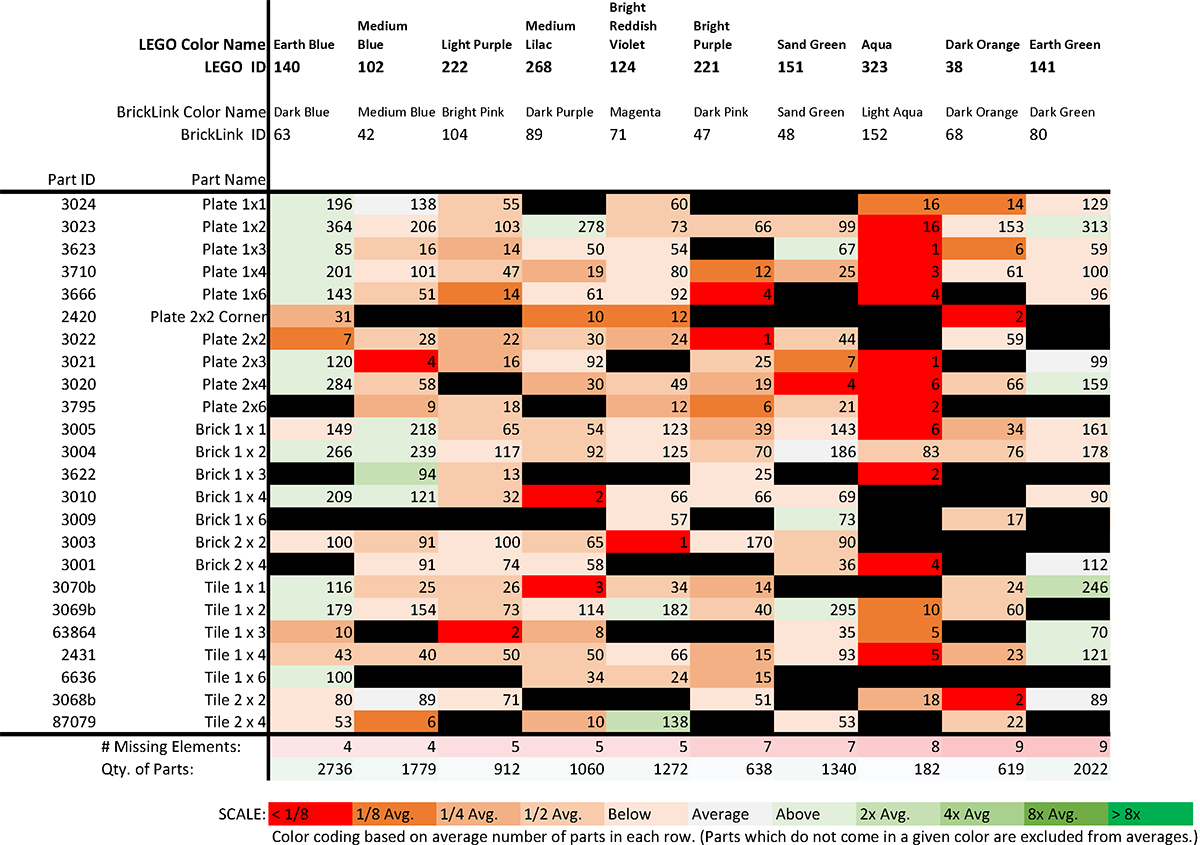
These 10 colors are really frustrating, because they are missing a number of common parts. (All of these colors were introduced in 2000-2004.)
To be fair, some of these colors will be more frustrating than others. (For example, it’s harder to workaround the lack of a 1×1 part than the lack of a 1×2 part, since you can often use two 1×1 parts as a substitute.)
Unfortunately, some really great colors are uncommon:
- 140. Earth Blue (Dark Blue) which gives models depth with this darker shade.
- 151. Sand Green which is one of a small number of low-saturation colors that is perfect for re-creating weathered copper surfaces.
- 38. Dark Orange which is an important complement to both brighter colors and earthtones.
- 222. Light Purple (Medium Pink), 268. Medium Lilac (Dark Purple), 124. Bright Reddish Violet (Magenta), and 221. Bright Purple (Dark Pink) are the four most common Pink / Purple colors.
Exactly why these colors aren’t available in all common parts is not clear to me. While most of these colors are relatively new, 38. Dark Orange was introduced in 1994, 102. Medium Blue was introduced in 1997, and 151. Sand Green was introduced in 2000. I really hope that the AFOL’s who work at LEGO find ways to sneak some of these missing parts into sets soon, allowing us to move these colors into the “Main Colors” group.
Rare Colors

Lastly, we look at those colors which remain very rare across the 24 common LEGO parts analyzed here. In some cases this is explained by the color’s purpose—two of the Nougat (Flesh) colors are used extensively for minifigure hands and heads, but rarely used in other places. Many of the other cases are likely attributable to colors which were only recently added to the palette.
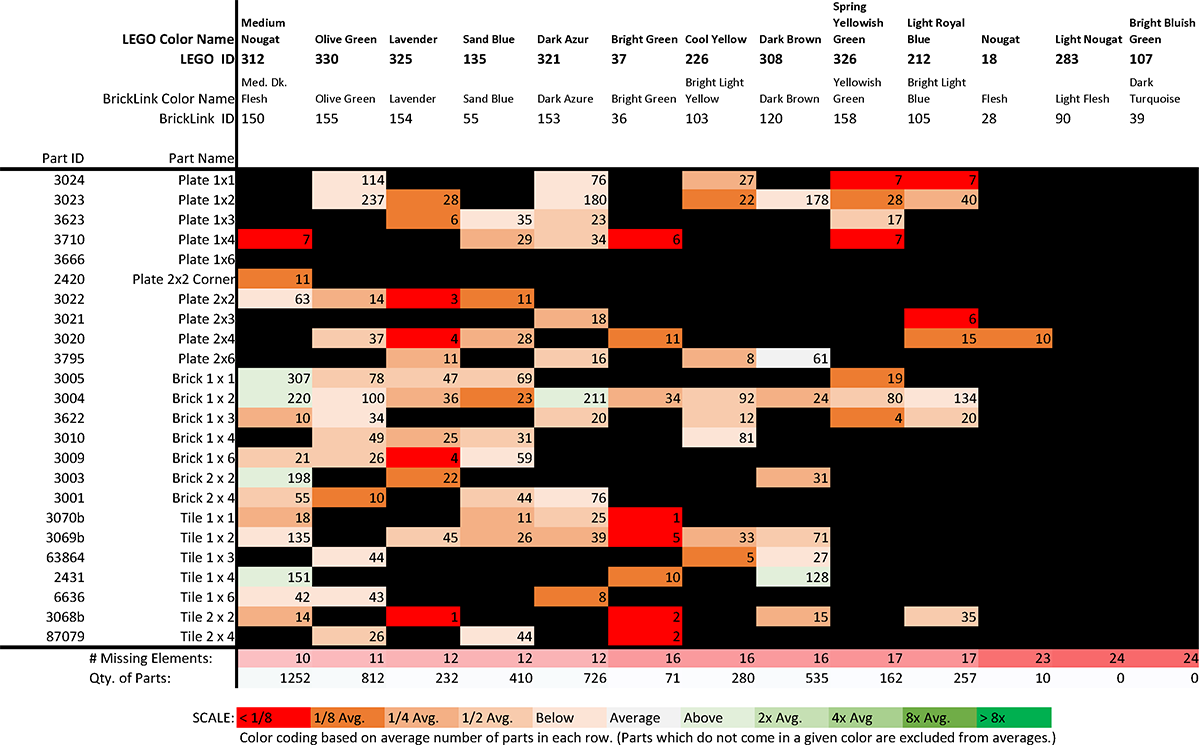
The remaining 13 colors are rare enough that you can only reasonably use them for accents.
Surprisingly, not all of these colors are new. 135. Sand Blue has been around since 2001, but still only comes in just 12 of the 24 parts listed here. (This is unfortunate; low saturation colors add realism to MOC’s.) 312. Medium Nougat is another odd example, since it is relatively common in bricks, but very rare in plates.
Cheap vs. Expensive Colors
A second way to look at the color palette is to consider which colors are cheaper and more expensive to buy. Not surprisingly, the most common colors also tend to be the least expensive, but there are some unexpected surprises when you dig in to the data.
All prices are based on the sales from the Last 6 Months on Bricklink of new pieces in larger quantities. (Data pulled 2018/01/12)
Least Expensive Colors
The charts also show that the most common colors are often the least expensive colors. This makes sense, since they are available in much greater quantities.
That said, there are a couple relatively common colors that are significantly below the average price (for the 24 common parts explored in this article):
- 119—Bright Yellowish Green (Lime) parts are the cheapest, at 40% below average.
- 192—Reddish Brown, 21—Bright Red (Red), 24—Bright Yellow (Yellow), and 23—Bright Blue (Blue) are about 30% below average.
I found it a bit surprising that despite massive production volumes, the four most common colors are not significantly below average price. 194—Medium Stone Grey (Light Bluish Gray), 1—White, 199—Dark Stone Grey (Dark Bluish Gray), and 26—Black are only between 5% and 15% below average prices. I think it’s because these are popular colors for MOC’s, and supply is doing a good job of matching demand.
Most Expensive Colors
There are only three relatively common colors that are more than 50% above average prices. All three are relatively low-volume colors, and I think the prices are high because they are popular colors for MOC’s.
Most expensive colors:
- 151—Sand Green is the most expensive color, at more than double average prices.
- 323—Aqua (Light Aqua) is about 80% above average prices.
- 38—Dark Orange is about 55% above average prices.
While a specific part in a specific color might be particularly expensive, the majority of colors cost roughly the same price. That said, you might want to do a little research before getting your heart set on a particular color for your next big build—you might find the parts you need don’t exist or are more expensive than you had hoped!
Out-of-print and non-production parts
You also might notice that there are quite a few part/color combinations that haven’t been produced recently, but are available on BrickLink to purchase. This could be due to a number of factors including: it was included in sets more than 5 years ago, it was incorrectly listed on the site, or it was never included in a LEGO set, but a handful escaped the factory through various channels (including LEGO employees, or the design studios at LEGOLAND theme parks.) These are called non-production color parts.
A few of the many parts which you can buy on BrickLink even though they don’t appear to be included any current sets:
- 28—Dark Green (Green) – Tile 1×6. Three were included in one set from 2009. 0.44$
- 138—Sand Yellow (Dark Tan) – Brick 1×3. Not available in any sets. 5.89$
- 140—Earth Blue (Dark Blue) – Plate 2×6. Two were included in one set from 2003. 6.55$
- 140—Earth Blue (Dark Blue) – Brick 2×4. Included in four sets from 2008-2011. 0.47$
This analysis has changed how I look at my collection—I’m focusing my attention on filling in gaps in the most common colors, and only those uncommon colors which are most useful for building Architecture models. The data reinforced my inclination to continue avoiding the rare colors, because finding the parts you need is difficult and expensive. (I’d be happy to see 135—Sand Blue, and 308—Dark Brown become available in most common parts.)
Subscribe for more articles like this!
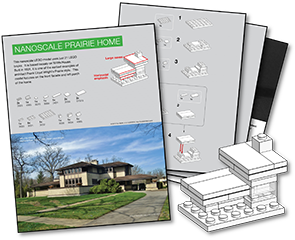
Subscribe to the Brick Architect newsletter for early access to exclusive content, the latest articles, and updates to the Printable LEGO Brick Labels, LEGO Storage Guide, and my book The LEGO Architect.
Appendix: Methodology
This article is the first I’ve seen which measures the usefulness and cost of each color by comparing cost and availability across a set of common parts. I chose to focus on Bricks, Plates, and Tiles, as these are the core building elements required to build almost any model (using System pieces.) In the future, I may cast a wider net to see if any of the colors end up in a different category if we include other common parts in the analysis (such as: Round 1×1 Plate, Cheese Slopes, Grille, Jumpers, Bow.) I also want to see if any of the Transparent, Metallic, or Glow Colors are more common than I think.
Criteria for inclusion in my list of “common” parts included both:
- Part available in 20 or more colors.
- if you bought one of each set between 2013 and 2017, you would have 3000 or more of that part across all colors.
The data used for this article comes from two sources: BrickLink for Cost Data (prices on 2018/01/12), and Rebrickable for Set Inventories (downloaded 2018/01/10)
The cost data was pulled from Bricklink using the BrickStock app. This data was saved as a .bsx file, which can be imported into Excel.
STEPS: Create a list of “common” parts with quantity of 1 each, copy/pasted 40 times and modified to include all parts in all 40 colors, “extras > update database”, “edit > price > set to price guide” using options “Last 6 months sales” / “Quantity Average”, Save Changes.
The number of parts for each part/color was derived from the latest data you can download from Rebrickable.
STEPS: I re-created the database structure in Access, added two additional tables to help normalize the data and drive my queries: 1) Table of color names & color ID’s across LEGO/BrickLink/Rebrickable databases. 2) A table of parts that I care about for this report. This allowed me to make a single query listing all elements from all sets from 2013-2017, along with Part ID and Bricklink Color ID.
Finally, the output of that data feeds into an excel spreadsheet that has color ID’s across the top, and Part ID’s across the left. One workbook counts the number of parts in each part/color combination from the data exported from Access. The second workbook finds the latest Brinklink prices for each part/color from the table outputted from BrickStock app.
Possible Errors in analysis:
- Price data is based on new parts available in large quantities from the last 6 months. Might be significantly different if used parts were included, or if prices changed very recently.
- I only looked at 24 common parts. It is entirely possible that some of these colors are significantly more/less common, or more/less expensive in different parts. (I know that the two Nougat/Flesh colors are mostly used for Minifigure hands and heads.)

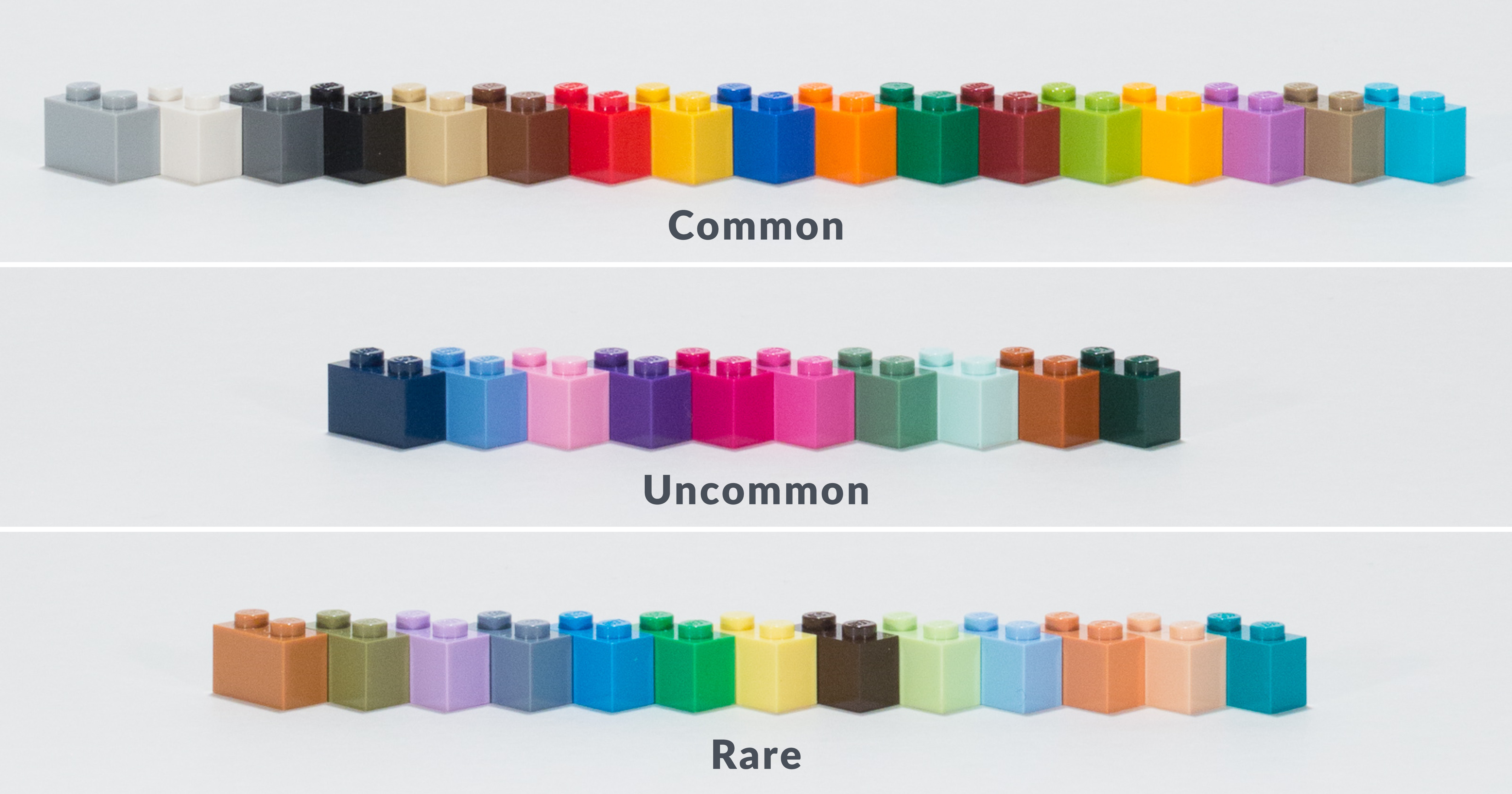
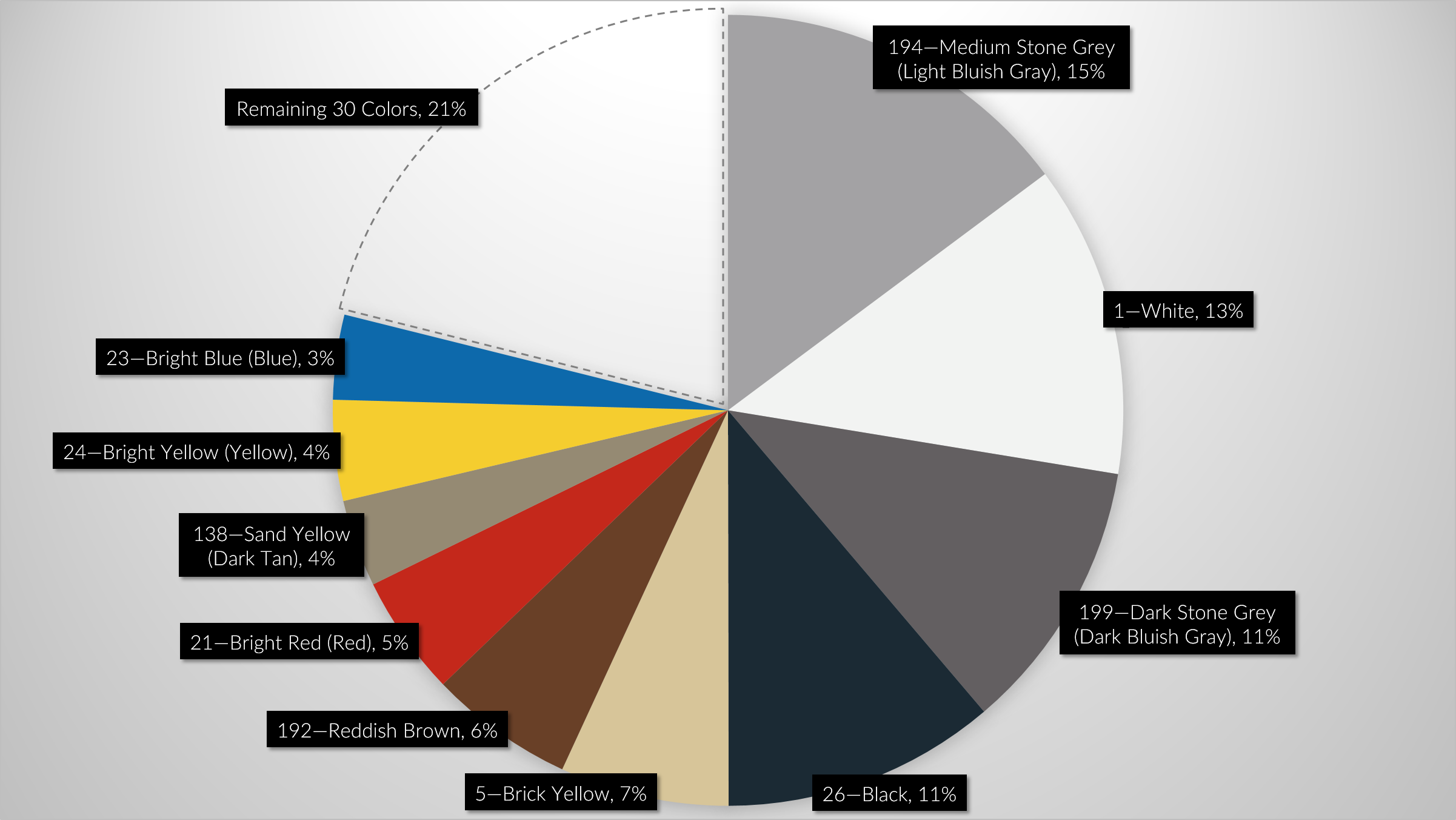

Just checking in again as this article is now four years old and I think everyone would like an update to it. When you replied a year ago, I thought you would of updated it by now, as “eventually” doesn’t normally mean over a year later. Please let us know when an update is coming as some of the rare colours are more common now, etc…..
I probably will update it soon, especially since we have two new colors since the article was published (Vibrant Yellow, and Vibrant Coral).
As for an updated ranking of the colors, you can find that in another article I updated recently: https://brickarchitect.com/lugbulk/ (Click on the second table in the article for an even more detailed PDF, with colors ranked from left to right based on 2017-2021 data.)
—Tom
Thanks. Enjoyed the article.
Came across your awesome site. I see this article is over 3 years old now. I really hope you are able to do an update as there has been some great sets that have come out since the article was written.
John,
I hope to update it eventually. Good news is that some of the less common colors have increased in availability. One of the most noteworthy change is the growth of Cool Yellow, thanks largely to the new Fiat 500 set .
—Tom
I landed here whilst looking for any explanation of why transparent clear bricks and tiles are so rare and expensive (up to 2 EUR for a 1×8 clear brick). I know transparent clear bricks have never stuck together very well and they seem to yellow with age, so perhaps that’s why LEGO shows little love toward producing them.
I’m a little surprised you didn’t regard trans-clear (or any transparent colours) in your study.
I have a MOC requiring 400+ clear transparent bricks but it’ll be on the back-burner unless I luck onto a huge batch of stock.
Steve,
I may update the analysis in the future to include all of the translucent colors (including the “clear” part which is commonly described as “transparent”). I haven’t looked as closely at these parts, because (as you noticed) they are available in a very small subset of moulds, including very few basic bricks and plates.
You are correct that they do not stick together the same as colored bricks. That’s because it’s made of a different type of plastic. Colored bricks are ABS, whereas translucent bricks are Polycarbonate (PC). It’s clear, but not as good of a plastic in other ways including the fading problems you described and harder to snap together or remove.
and if all else fails, it’s nothing a can of spray paint won’t fix.
(Your mileage may vary!)
This information is certainly very helpful. At home we argue to fine rare pieces by analysis our own LEGO lots. With referring these information we can easily keep our rare pieces in separate boxes.
Please! Reduce the number of colors = have a chance to keep LEGO principle for future. (Even currently I rather buy old/vintage set instead new because of many “incompatible” colurs.)
Jan, you are absolutely right that it is increasingly difficult to get enough parts in a single color to build anything interesting. While helpful for LEGO artists, I would not be happy to see a lot of new colors for this reason.
Sticking to a couple LEGO themes can help, as something like Star Wars gives you a lot of Light and Dark Gray, whereas Architecture might give you a lot of Tan pieces.
Great analysis! I have noticed with the increase in sand green in sets in 2017 (70612 ninjago green dragon mech; 21136 Minecraft ocean monument; 21310 old fishing shop ), some elements are now cheaper through LEGO customer service ‘bricks n pieces’ than bricklink -esp the 1×6 brick. Thanks again
Is there a source for photo-ID of colors and their names? Also, I believe I noticed this doesn’t get into transparent colors. That is a factor as well, when building.
Thanks for the great article!!
Ryan H.’s Flickrstream is probably one of the best sources (even for retired colors), although it’s a bit hard to navigate through.
https://www.flickr.com/photos/126975831@N07/albums/72157649729890049
Ryan kindly let me use his images at Brickset, which provides a means of filtering them into colour families/retired/current etc.
https://brickset.com/colours/status-All
MSG has also been very common in Castle- and Fantasy-based themes, such as LOTR, The Hobbit and POTC.
Although it’s possible most of those sets are more than five years old by now.
Thanks for the article! Frustrating sometimes to discover that creating something is not ideally possible due to some missing common part in a common colour. I was surprised that the “common parts list” has almost only regular plates, bricks and tiles. Sometimes very common slopes SNOT pieces are not available in common colours. It would be nice if Lego would start some custom colour moulding for consumers, at least if there is enough call for some part.
You are absolutely right—I started with just common Bricks/Plates/Tiles for this analysis, but fully acknowledge that many slopes (especially Cheese), curves, and various SNOT parts are extremely important and very common. I may update the article with analysis of other parts in the future, especially if people like you continue to let me know that this type of in-depth analysis is valuable.
thanks,
—tom
That’s much appreciated, thank you.
Jelle
Really interesting article!
It would also be interesting to know how the inclusion of specific themes affect these numbers. I wonder if the quantity of Star Wars set is what make medium stone grey so common
Thank you for this analysis.
One comment, the Dark Turquoise parts Brick 1×2, 1×3, 1×4, Plate 1×1, 1×2, 1×3, 1×4, 2×4, 2×6 and Tile 1×2, 1×4 should be available from earlier production sets. (Color variation between old and new parts shouldn’t be bigger than different batches of the same color in current production.)
Also, I think it’d be interesting with a similar analysis of common slope parts, if there’d exist the time and energy.
I forgot to mention this in the section about prices – you can actually buy a wide range of Dark Turquoise parts right now, even in “new” condition since parts in that color were not retired all that long ago.
I’m curious to see how many different parts we see in Dark Turquoise by the end of 2018.
Fascinating analysis, thank you! I will sometimes concentrate on a colour for roof rather than wall use (sand green for instance) – it would be interesting to see a similar analysis of slopes.